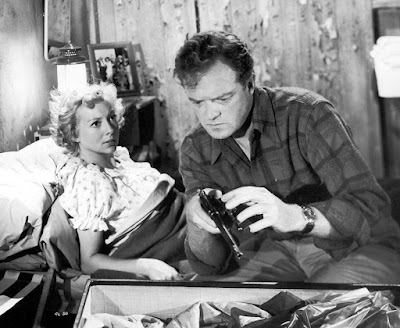Albert Band brings his
long list of B-movie credits into play for this United
Artists macabre tale about a man who thinks he may be affecting
people’s lives by using push pins. I note the excellent cinematography effects by Frederick Gately, below. Still, the score by the award-winning composer, Gerald Fried, sets the stage for a spooky tale using a harpsichord, a frantic tempo, and dissonant chords. The movie seems like an extended episode of television’s, Night Gallery. The viewer is sucked in right from the opening credits with a statement suggesting that some men (mankind) have the ability of great mental power over events—the old “man as God” thing—and that the dead are simply biding their time underground until released back into the unemployment lines. Do not be misled by the studio's poster. There is nothing scary about this film. It is spooky, ghost-believing science fiction at best. As is typical of low-budget “horror” movies, the ending is disappointing with the outcome as expected. It may have, however, elicited some talk around the office water cooler in the era.
Richard Boone is appointed
chairman of a committee that oversees a large cemetery. His acting skill shows restraint and does not go overboard with the character’s emotions. He is quite creditable and, as usual, improves this film. A thirty-four-year-old Theodore Bikel, the caretaker, does his best old man routine with a Scottish accent in one of the more obvious wigs from makeup artist, Jack Pierce, who may have lost interest in the film at some point. Bikel is not that convincing but he had a nice limp going there for a while.
Black pins mark the filled graves on a map
resembling a Picasso sketch of the cemetery grounds. The white pins indicate
unoccupied graves. Boone accidentally places two black pins where
they should not be and both persons mysteriously die in an automobile
accident—surely a coincidence. But it repeatedly happens either
through experimentation or challenges from doubters. Boone believes
he is cursed and he falls helplessly into a deep depression.
The body count is up to
seven from Boone’s pin-pushing spree. In an epiphany, he decides
that if black pins give him the power of death, white pins might give
him the power of life. He replaces all of the black pins with white
pins. He discovers that certain graves have been dug but no casket in the plots. If you believe in this preposterous scheme, the climactic
finish may spoil it. Hokum has an equally powerful force over people.
I should mention that Bickel’s character is nuts.
Note: Some cinematography
effects are artistically well done by Gately. The map causes
much distress for Boone and near the climax appears to glow, consuming Boone. At one point, after being struck by
Bikel, an overhead light swings back and forth casting light and
shadows across the pins in the map creating a dizzying optical
illusion. Another has Boone’s silhouette superimposed on
the map as an animated graphic illustration, eliciting an out-of-body
experience for him. Watching this film may have the same effect.

































